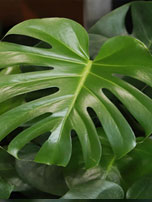SHAHEED KARTAR SINGH SARABHA AYURVEDIC MEDICAL COLLEGE & HOSPITAL
Affiliated to Guru Ravidas Ayurved University, Hoshiarpur Punjab
Affiliated to Guru Ravidas Ayurved University, Hoshiarpur Punjab

Botanical Name : Monstera deliciosa
Family : Araceae
Introduction :
Monstera deliciosa, the Swiss cheese plant, is a species of flowering plant native to tropical forests of southern Mexico, south to Panama. It has been introduced to many tropical areas, and has become a mildly invasive species in Hawaii, Seychelles, Ascension Island and the Society Islands. It is very widely grown in temperate zones as a houseplant.
The plant may be confused with Thaumatophyllum bipinnatifidum, known as the Split-leaf Philodendron or Tree Philodendron, as they have similar leaves and growing habits. However, the ingestion of Thaumatophyllum bipinnatifidum may cause irritation to the digestive tract and will induce internal swelling. The sap is also known to irritate the skin.
Names in different Indian languages :
English: delicious monster, fruit salad plant, fruit salad tree
Morphology :
This member of the arum family Araceae is an epiphyte with aerial roots, able to grow up to 20 m (66 ft) high in the wild, with large, leathery, glossy, heart-shaped leaves 25–90 cm (10–35.5 in) long by 25–75 cm (10–29.5 in) broad. The leaves on young plants are smaller and entire with no lobes or holes, but soon produce lobed and fenestrate leaves as they grow. Although it can grow very tall in nature, it only measures between 2 and 3 m (6.6 and 9.8 ft) when grown indoors. The leaves are large (up to 1 m or 3.3 ft long), heart-shaped and pinnate. The older the plant, the more the leaves are covered with its familiar large perforations.
Wild seedlings grow towards the darkest area they can grow until they find a tree trunk, then start to grow up towards the light, creeping up the tree.
The inflorescence is adorned with a cream-white spathe of uniform, velvety appearance, covering, like a hood, a yellowish white spadix 10 to 15 cm (3.9 to 5.9 in) high and about 3 cm (1.2 in) in diameter. Flowers are self pollinating, containing both androecium and gynoecium. Since they contain both structures, this plant is able to self-pollinate.
Fruit :
The fruit of Monstera deliciosa is up to 25 cm (10 in) long and 3–5 cm (1.2–2.0 in) diameter, and it looks like a green ear of maize covered with hexagonal scales. As the fruit ripens, these scales or platelets fall off the fruit, releasing a strong and sweet scent. The smell has been compared to a combination of pineapples and bananas. The fruit is edible and safe for humans.
Fruits of plants of the Araceae (Arum family) often contain raphides and trichosclereids – needle-like structures of calcium oxalate. In M. deliciosa, unripe fruit containing these needle-like crystalline structures can cause irritation of the mouth.
It takes longer than a year for fruits to reach maturity. The fruit first shows signs of ripening by the yellowing of its lowest scales. As it ripens, the starch that was stored in the green fruit is converted to sugar, giving it its sweet flavor. This mechanism is comparable to how banana fruits ripen. The strong odor the fruit produces becomes noticeable when it is half-ripe. As time passes and the fruit continues to ripen, the odor becomes stronger. After it becomes fully ripe, however, the scent deteriorates quickly.
Distribution & Habitat :
his plant lives in the humid tropical forests, in the lowlands and middle mountains.
Uses :
Aerial roots used to make a remedy for snakebite
